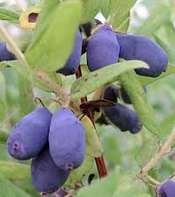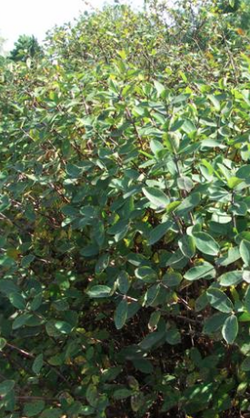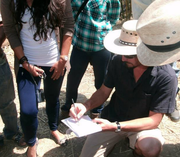 Lonicera kamschatika, haskap Lonicera kamschatika, haskap We can think of at least 180 great forest garden & perennial crops for cold climate Sweden. Want to hear about them? Over the course of the next year we will profile 5 a week on the blog. Perennial plants and crops offer a low energy, oil & resource input based foundation for future-proof agricultures. By default if an agriculture is to be called regenerative the bottom line is that it must be soil building, not soil depleting. Relentless deep tillage & poor soil husbandry (wifery?!) contributes to the majority of the 24 billion tons of topsoil lost every year on planet water. We are going to be focused on holistic polyculture grazing and perennial production at ridgedale over most of the site as this represents the most effective way to restore our degraded landscape, produce high value produce and ensure the future resource base we are managing holistically for in our decision making.  Genus Lonicera Species kamschatika Common Name haskap, edible honeysuckle Form shrub Habit clumping Origin Asia Light sun Moisture mesic Edible fruit Lonicera caerulea (blue-berried honeysuckle or sweetberry honeysuckle) is a honeysuckle native throughout the cool temperate Northern Hemisphere. It is a deciduous shrub growing to 1.5–2 m tall. The leaves are opposite, oval, 3–8 cm long and 1–3 cm broad, glaucous green, with a slightly waxy texture. The flowers are yellowish-white, 12–16 mm long, with five equal lobes; they are produced in pairs on the shoots. The fruit is a blue berry about 1 cm in diameter. Haskap: an ancient Japanese name of the Ainu people (also spelled phonetically as Haskappu, Hascap, Hascup) but still used today in Japan and in North America. Russia's N.I. Vavilov Institute of Plant Industry has the longest history of collecting from the wild and breeding this crop. L. c. var. edulishas been used the most in their breeding efforts but other varieties have been bred with it to increase productivity and flavour. In Japan (Hokkaido Island) and in the Oregon State University Haskap breeding programs, L. c. var. emphyllocalyx has been the dominant variety used. The University of Saskatchewan Breeding Program in Canada is also emphasizing L.c. var. emphyllocalyx but is also hybridizing with Russian varieties and L. c. var. villosa. At 1.5 meters the plants can remain as individual bushes for many years. Plants will grow to be 1.5 to 2 meters tall and wide. It can survive a large range of soil acidity, from 3.9-7.7 (optimum 5.5-6.5). Blue-berried honeysuckle plants require high organic matter, well drained soils, and lots of sunlight for optimum productivity. Lonicera caerulea plants are more tolerant of wet conditions than most fruit species. Harvest season can be 2 weeks before strawberries for Russian type varieties but Japanese types will ripen at a similar time to strawberries. Two compatible varieties are needed for cross pollination and fruit set. This is a northern-adapted species that can tolerate very cold temperatures; in North America, most Russian varieties are adapted to hardiness zones 1 to 4. Gardeners in zones 5 and 6 probably would need to use the Japanese varieties, which are far less likely to grow during warm periods during winter. The southern range of this plant is not yet known. Often it will fruit in the year after being planted, even if very small. Perhaps by the 3rd year 1 pound (1/2 kg) may be harvested. The plants may take three or four years to produce an abundant harvest. Average production on a good bush is about 7 lbs (3 kg). Blue-berried honeysuckle can be used in processed products: pastries, jams, juice, wine, ice cream, yogurt, sauces, and candies. When frozen fruit is placed in the mouth it melts away. Seeds are not noticeable when eating but if they are observed they are similar in appearance to seeds found in kiwifruit. The skins simply disintegrate which has caused some excitement amongst ice cream and smoothie makers. The fruit also turns dairy products into a bright purple-red. It can make excellent wine, some say similar to grape or cherry wine. The wine will be a rich burgundy colour. Its juice has perhaps a 10 to 15x more concentrated color than cranberry juice. Last chance to join our unique 10 Week Permaculture Internship! We're gearing up for what is looking like possibly the most exciting Permaculture training happening in Europe this year, in fact we're running two;April- July Jul- Sept Read all about it at the links above and join an awesome team from all over the globe as we regenerate this old farm into a thriving & diverse local integrated food hub....
1 Comment
|
Details
Like us on FB Below for regular updatesStay up to date with customized updates you want to receive
Upcoming coursesArchives
December 2016
Categories
All
|

 RSS Feed
RSS Feed